Teenage pregnancies: P35B annual PH loss, other costs
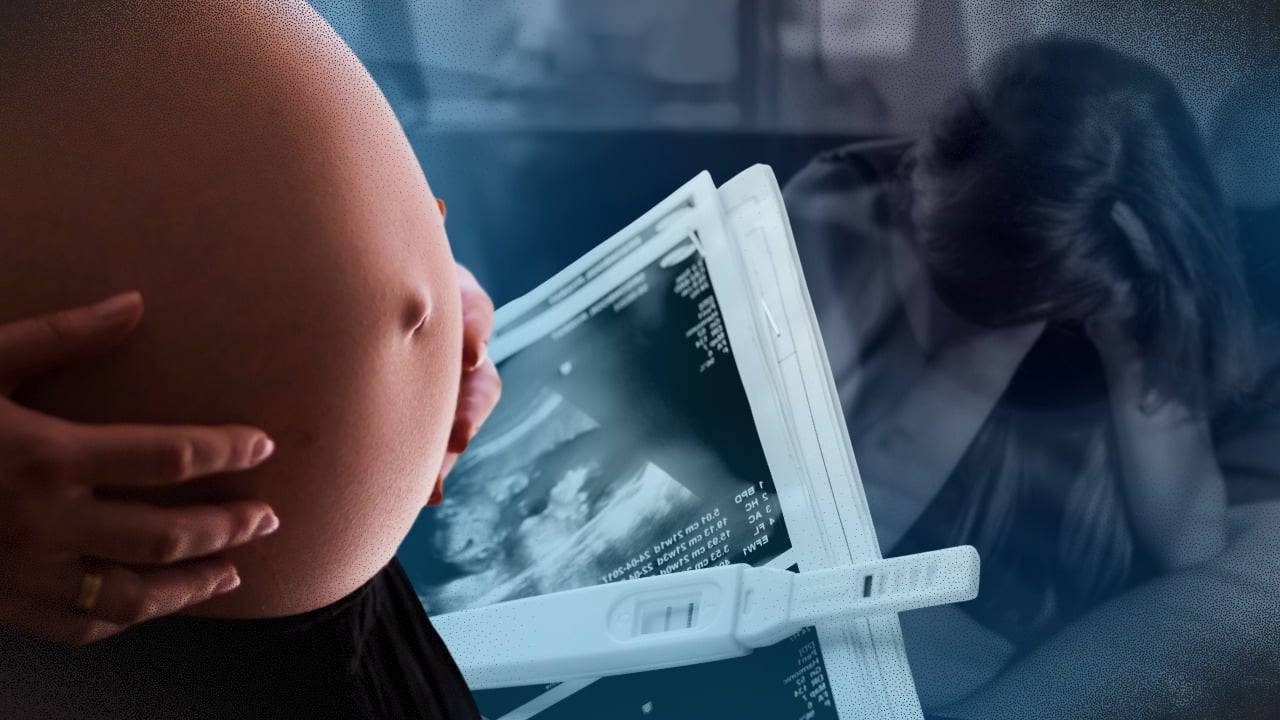
INQUIRER FILE PHOTOS
MANILA, Philippines—While cases of teenage pregnancy are already declining, the government insists there’s no room for complacency with the Department of Health (DOH) saying there’s a need for programs to provide “lasting impact in addressing teenage pregnancies.”
This was the reason that Health Undersecretary Maria Rosario Vergeire, Department of Health officer-in-charge, said the project “Accelerating the Reduction of Adolescent Pregnancy in Southern Leyte and Samar” was important as it “provides a holistic, multi-sectoral approach to addressing adolescent pregnancies in the country.”
Last week, government officials, representatives of the Korea International Agency (KOICA), and the United Nations launched the said project that aims to address the high rates of teenage pregnancies in the Philippines, with Southern Leyte and Samar as pioneer provinces.
Funded by KOICA, the project seeks to “improve access of the adolescent population to sexual and reproductive health services and information (SHR), raise their self-awareness on sexual reproductive health and rights, as well as to enhance leadership and governance on adolescent SRH.”
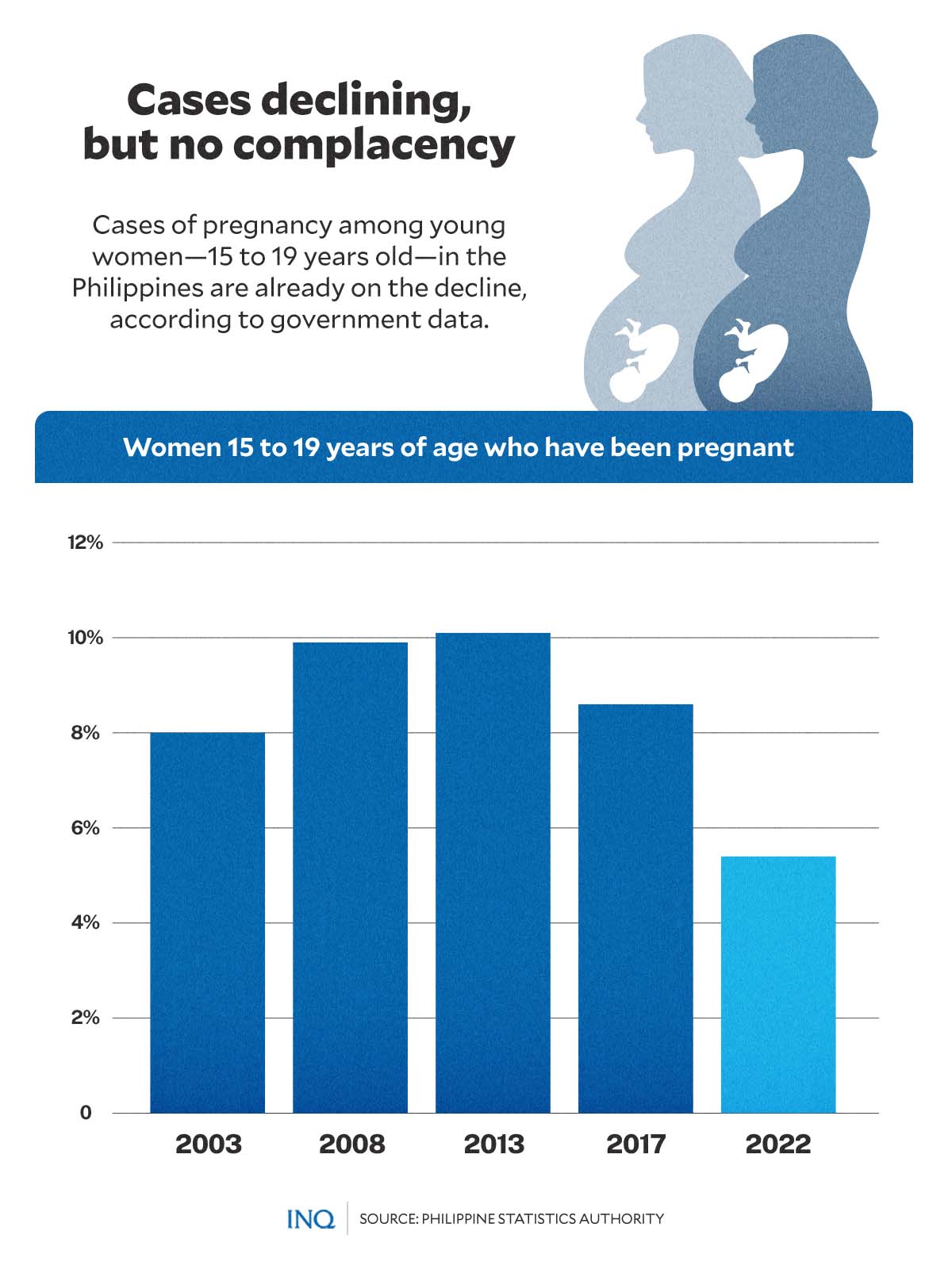
GRAPHIC Ed Lustan
Kim Eunsub, KOICA country director, said “Korea is committed to support the Philippines in its goals to achieve universal health for all.”
Article continues after this advertisement“This is the first time that KOICA is working on a joint project on adolescent health in partnership with the three UN agencies in the Philippines,” said Kim.
Article continues after this advertisementBut why is this needed?
As stressed by Vergeire, “one of the critical issues that many adolescents face is early and unwanted pregnancies,” and as the World Health Organization (WHO) said, “when a girl becomes pregnant, her present and future change radically, and rarely for the better.”
According to data from the Philippine Statistics Authority (PSA), there were 5.4 percent of women 15 to 19 years of age who have been pregnant in 2022, lower compared to 8.6 percent in 2017, 10.1 percent in 2013, 9.9 percent in 2008 and 8 percent in 2003.
READ: Numbers fall but PH teen pregnancies persist, mirror economic, learning gaps
The 5.4 percent, the PSA said, translates to 5,531 women. One of them is 18-year-old Mae Mendez.
Mendez, who is living in Samar, told INQUIRER.net that she was only 17 years old when she got pregnant last year by her boyfriend, who was 20 years old then. She gave birth to her child this year and went back to school as a Grade 11 student.
The UN said the Philippines has one of the highest teenage pregnancy rates among ASEAN states, with one out of 10 births from mothers below the age of 19. With a 56 percent rate, the Philippines is the second highest, next to Laos, which has a rate of 64 percent.
READ: 1 out of 10 of live births in PH are to adolescent moms — PSA
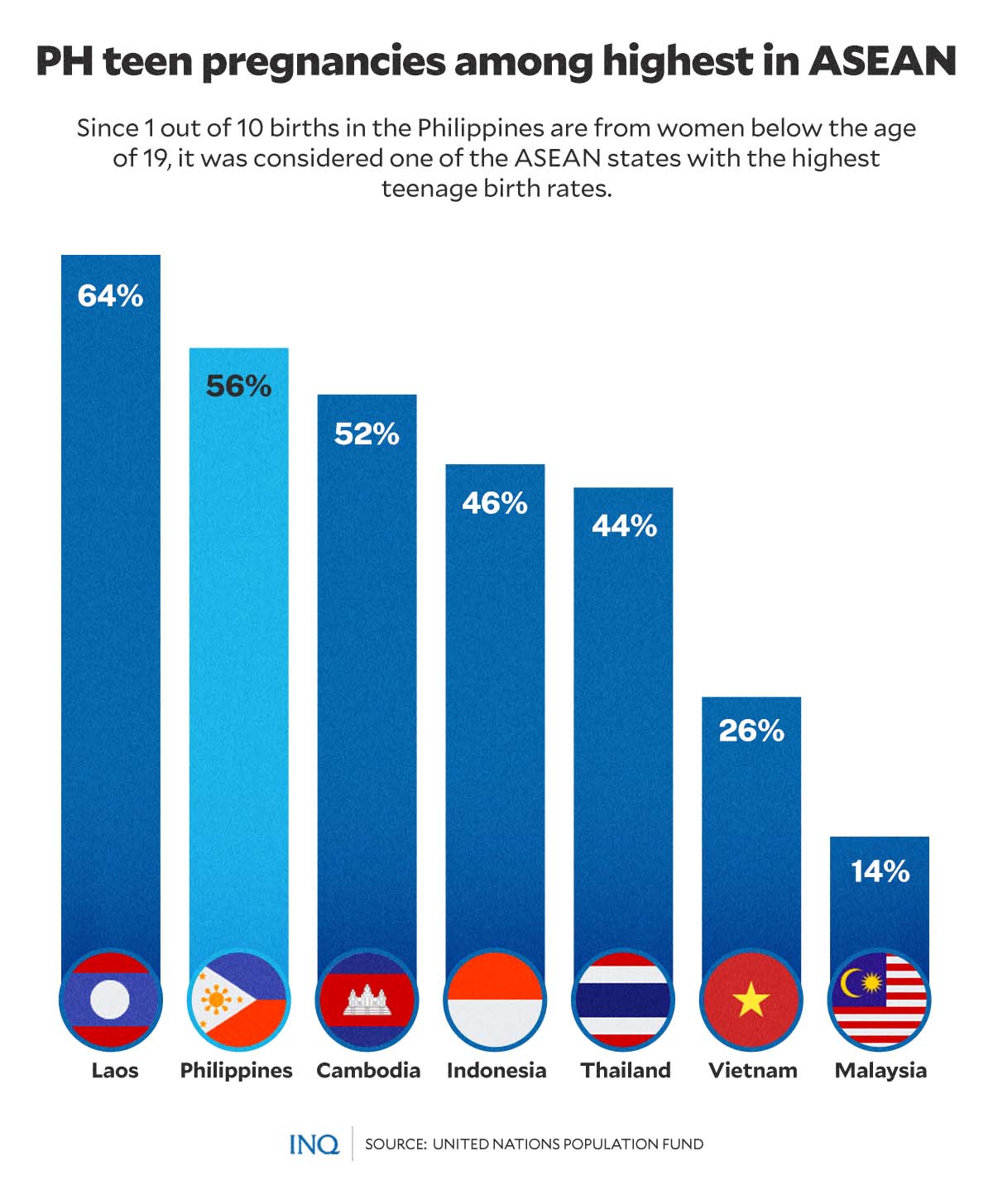
GRAPHIC Ed Lustan
Based on data from the UNFPA, next to the Philippines are Cambodia (52 percent); Indonesia (46 percent); Thailand (44 percent); Vietnam (26 percent); and Malaysia (14 percent). It said rates are still high although efforts to reduce adolescent pregnancies contributed to great progress in the last decade.
RELATED STORY: Majority of Filipinos consider teenage pregnancy as women’s most important problem—SWS
But as the United Nations Population Fund said, while the number of total teenage births is already declining, the number of births by mothers 10 to 14 years of age was increasing with the PSA saying that there were 2,113 cases in 2020, and then 2,299 in 2021, based on data from the DOH.
READ: Pregnancy among girls below 15 rising – PopCom
INQUIRER.net talked to Sheryl (not her real name), who gave birth to her child last year. She was only 13 years old when she and her boyfriend, who was already 19 years old then, engaged in a sexual activity. Both of them are from Samar, one of the pioneer provinces for the Philippines-KOICA-UN project.
READ: PopCom raises alarm over children as young as 10 getting pregnant
Some 59.5 percent of teenage births in the Philippines were fathered by men older than 20 years old
Which region has the highest rate?
Based on data from the PSA, Eastern Visayas, the region where Southern Leyte and Samar belong, has a teenage pregnancy rate of 4.9 percent in 2022, way lower than Northern Mindanao’s 10.9 percent, which is the highest in the Philippines.
However, as explained by KOICA and the UN, while provinces in Eastern Visayas were chosen as “pioneers,” they hope that the project will be expanded to reach more regions, especially the ones with the highest rates.
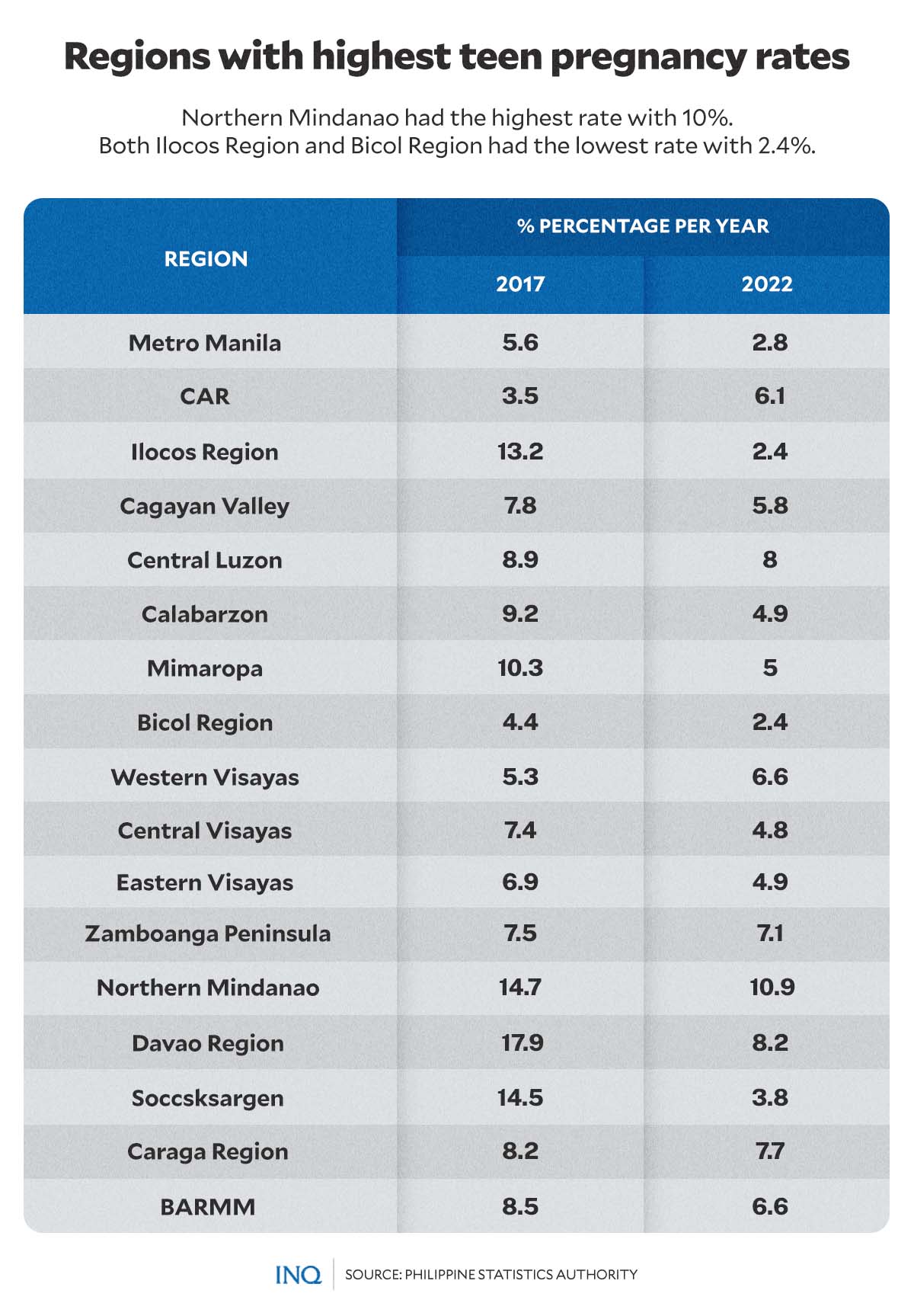
GRAPHIC Ed Lustan
Besides being one of the Philippines’ poorest and most typhoon-battered regions, the 2021 Young Adult Fertility and Sexuality Study indicated that Eastern Visayas has the highest rate of 15 to 19-year-old women who had been pregnant.
Out of 17 regions, Northern Mindanao had the highest, followed by Davao Region (8.2 percent), Central Luzon (8 percent), Caraga Region (7.7 percent), Zamboanga Peninsula (7.1 percent), Bangsamoro Autonomous Region in Muslim Mindanao (6.6 percent), and Western Visayas (6.6 percent).
Ilocos Region had the lowest rate at only 2.8 percent. Next were Metro Manila (2.8 percent), Soccsksargen (3.8 percent), Central Visayas (4.8 percent), Calabarzon (4.9 percent), Eastern Visayas (4.9 percent), and Mimaropa (5 percent).
At 6.1 percent, the PSA said the Cordillera Administrative Region has the highest increase in cases of teenage pregnancies compared to its rate in 2017, which was only 3.5 percent. Western Visayas also recorded a significant increase—from 5.3 percent to 6.6 percent.
The PSA said 19-year-old women had the highest incidence of teenage pregnancies in 2022 with 13.3 percent, while pregnancies in women aged 18 was at 5.9 percent, 17-year-old women at 5.6 percent, 16-year-old women at 1.7 percent, and 15-year-old women at 1.4 percent.
Significant social issue
While Vergeire said teenage pregnancy is “first and foremost” a health issue as evidence shows that early pregnancy increases the risk of maternal mortality, she acknowledged that it is also a social issue “that often results in poor lifelong social and economic outcomes for both the adolescent mother and her child.”
She said based on a study by the UN, teenage mothers are less likely to complete high school or college education, and are more likely to be jobless and to be poor. “The poor outcomes also extend to their children.”
Gustavo Gonzales, resident coordinator of UN Philippines, said: “Adolescent pregnancy is more than a health issue and more than an education challenge. It is a critical development problem where thousands of girls are systematically excluded from opportunities.”
RELATED STORY: PH teenage pregnancy declined to 6.8% but vigilance still needed – Popcom
As previously stated by the National Nutrition Council, early childbearing may result in poor health outcomes and may be a threat to the country’s economic growth as pregnant teenagers “are less likely to complete higher education.”
Because of this, the PSA said they may have “lesser ability to earn more income over the course of a lifetime, causing economic losses to the country,” P33 billion a year to be exact.
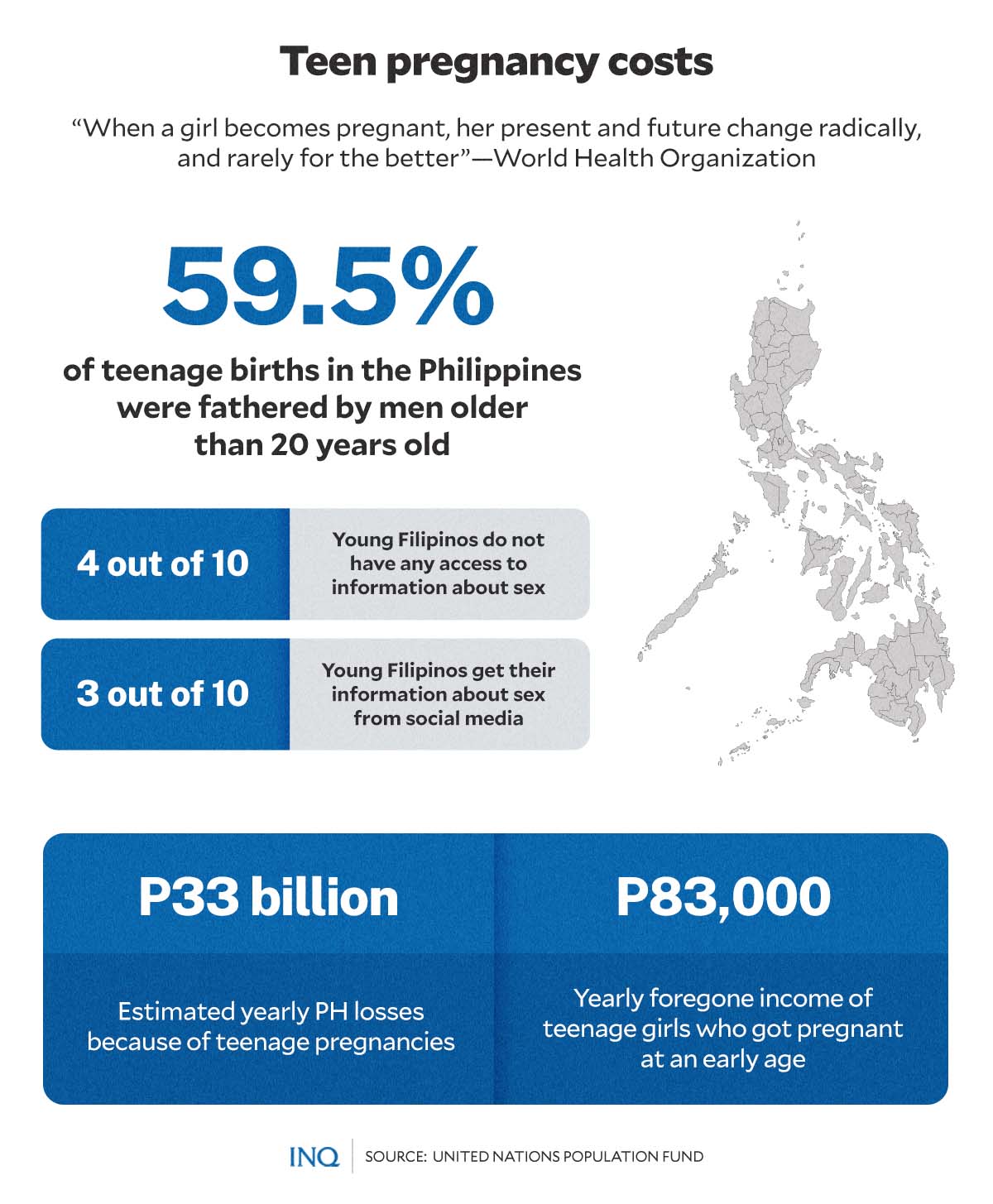
GRAPHIC Ed Lustan
UNFPA country representative Leila Joudane said “adolescents who get pregnant usually drop out of school [and] when they do, they have fewer chances of becoming active and productive members of society.”
As a result, they would earn less than those who finished their education: “Teenage girls who get pregnant and do not finish high school may lose earnings of up to P83,000 a year.”
P490-million assistance
As stressed by Vergeire, “a comprehensive strategy involving the different stakeholders is essential in providing a lasting impact in addressing teenage pregnancy in the Philippines.”
Based on data from KOICA and UN, the project, which started last year and is expected to end in 2026, has a budget of P490 million and will directly benefit 3,000 teenagers in Southern Leyte and Samar through the Youth Leadership and Governance initiative.
The project aims to provide 20 health facilities that are “adolescent-friendly” and 150 health care providers for care of teenagers. It will also include 150 teachers for the rollout of the Comprehensive Sexuality Education, which is expected to benefit 7,500 learners.
This, as almost four out of 10 young Filipinos do not have any access to information about sex and three out of 10 young Filipinos get their information about sex from social media.
The UN said “this can be problematic as the information they get from social media can be inaccurate, inappropriate and misleading.”
With the Philippines having one out of three (3) people under the age of 18, it is expected to benefit from the change of its population structure toward a younger demographic structure, the WHO said.
The problem, however, is that “the window opportunity that the demographic dividend brings may be lost if Filipinos are not able to care for their sexual and reproductive health and their families.“
The program’s efforts are expected to:
—Provide additional training for health workers and non-health service providers like social workers, teachers and peer educators
—Work on the expansion of PhilHealth package for adolescent pregnancy
—Provide mobile medical facilities to benefit adolescents
—Support the implementation of a Performance Accountability System for the local health and government units and a Youth Leadership and Governance initiative